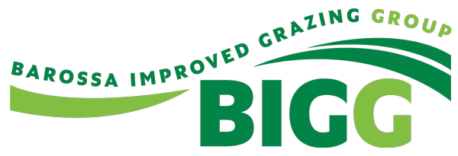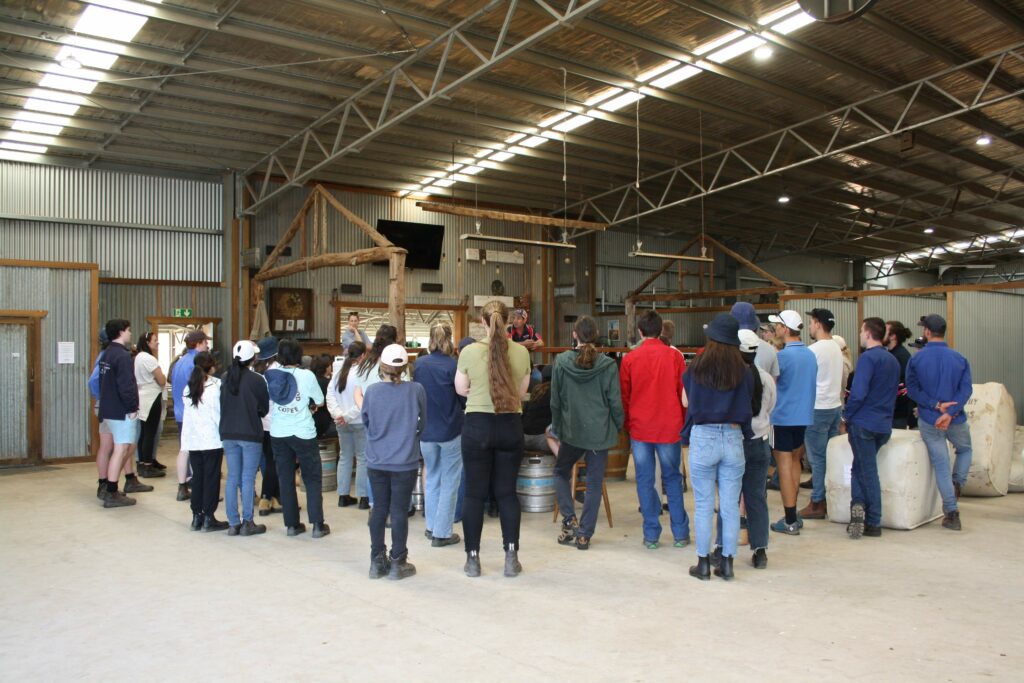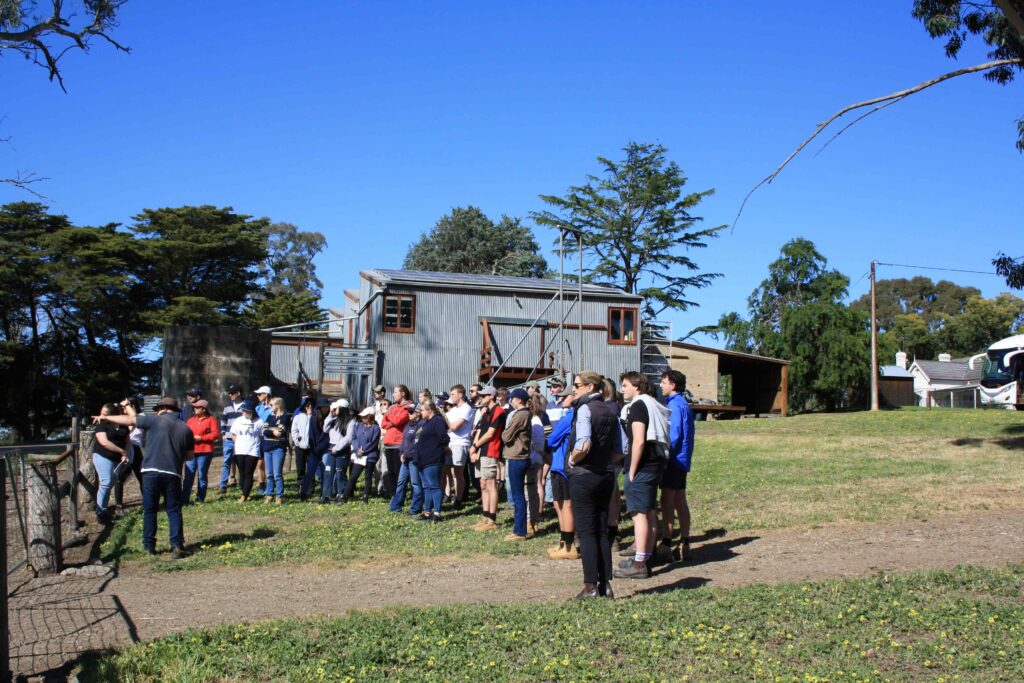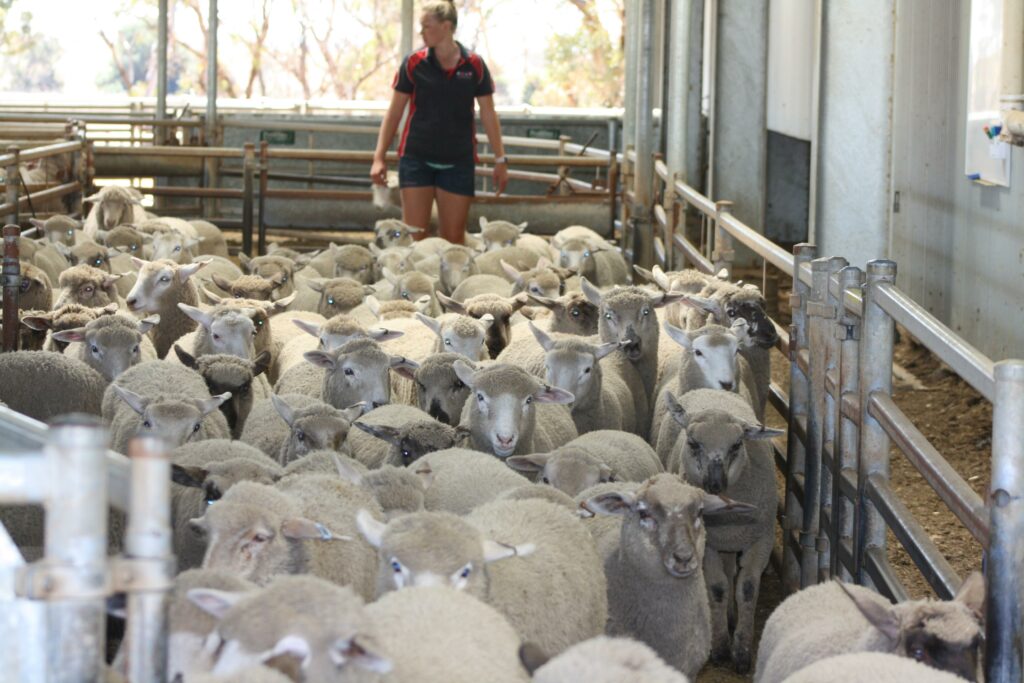Barossa Improved Grazing Group (BIGG) and Barossa producers hosted 100 second year University of Adelaide students on a tour of two livestock enterprises on Monday, 9th of October 2023.
Students visited Alex and Fiona McGorman’s “Thornby Lamb Feedlot” in Sanderston, and Michael and Jane Evans’ “Wootoona” sheep, cattle and horse enterprise in Flaxman Valley.
The tour aimed to;
- Demonstrate management practices used to ensure drought preparedness and resilience in a diversity of agro-climatic areas and mix of grazing livestock systems.
- Provide an opportunity for students to observe and/ or practice new skills.
- Outline the human capacity required by service providers and contractors to assist farm business operations and identify roles and jobs that might be of interest to students entering the agricultural industry.
This project is supported by the Foundation for Rural Regional Renewal (FRRR), through funding from the Australian Government’s Future Drought Fund.
Statements attributable to University of Adelaide participating students:
The view from the bus trips window showed how rainfall really does drop an inch per mile as you go east, evident in the vegetation alone. Despite the differences in production systems, they both utilized ag-tech and management strategies to be resilient and efficient. Due to water security, soil type and land capability and the general environment, “Wootoona” utilized a range of pastures to ensure environmental resilience while “Thornby” utilized cereal cropping and per sheep management to support the feedlot.
Jack Braunack & Oliver Fogarty
“Wootoona” receives 615mm annual rainfall, is a mixed livestock production system consisting of a 650ha property in Flaxman Valley as well as 1400ha east on the ranges which receives 400mm. The livestock enterprises consist of 500 self-replacing merinos as well as 1900 merino ewes mated to Poll Dorset for first cross lamb production, or Border Leister’s for BLxMo first cross ewe and wether lambs for sale to other producers, and also 100 breeding Angus cows. Michael shared that pasture management is a key priority on farm with pasture regeneration practices in place. Rotational grazing is the forefront of their pasture system, with 62 small paddocks across the 650ha to enable optimum grazing intensity for maximum pasture productivity and diversity. The timing of on farm pasture decisions is vital to ensure pastures are grazed when of highest nutritional value and before the reproductive phase, while optimising utilisation by the stock. The system is diverse to ultimately split risk. The property relies on 13 dams for stock water and is supported by a bore with reticulated water to most grazing blocks. The system and management strategies in place makes the enterprise largely drought resilient.
Lindsey Ould & Emily Pearce
“Thornby” has an average annual rainfall of 300mm and 3000ha is cropped with majority of income from lamb production, currently with a throughput of 120,000 lambs per year. Other enterprises include grain sales, firewood processing and wool production. In terms of water security, they have five different water sources which are used in the case of lack of low rainfall. Feedlotting is a much more intense system with a focus on high production per head through good genetics, lamb growth rate and the use of grain and supplementary feeding. It allows the value-adding of grain production and greater resilience and drought preparedness for other South Australian producers who regularly supply grain or fodder, and the feeder lambs to the feedlot to finish to the processors exacting specifications, so it’s a whole of supply chain system.
Lindsey Ould & Emily Pearce
“AgTech” was utilised on both properties, examples being para-sight and auto drafters at Thornby and normalised difference vegetation index (NDVI) satellite imagery being used at Wootoona. Para-site is an intriguing technology that allows for animal specific worming treatments in accordance with their worm burden, especially as purchased animals can have different worms and burden severities. The auto drafter is a labour efficient tool that allows animals to be sorted based on their electronic identification (EID) ear tag, sorting according to animal weight, worm burden or other desired readings to increase efficiency in sorting livestock. Wootoona utilises NVDI to monitor and make accurate decisions regarding their pasture management and livestock rotations as it is a crucial aspect of feed supply in their system. They also have soil moisture monitoring probe that gives advice on early drying of the soils, and assists in early in livestock de-stocking decisions in dry seasons.
Jack Braunack & Oliver Fogarty
“Workforce and student career opportunities” are valued and essential on both properties as they rely on local farm hands, contractors and service providers to run their business. These ranged from machinery operators, animal handlers, and the use of agronomists and animal specialists to produce the pasture and crops to feed their livestock to promote their growth and production. Both producers strongly emphasize the importance of engaging and supporting members of the community, building connections and participating in farming system and producer groups which attract projects from the likes of SA Sheep and Cattle Industry Fund, and this project is supported by FRRR, through funding from the Australian Government’s Future Drought Fund.

Above photos credit: Jim Franklin McEvoy, University of Adelaide



